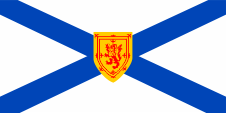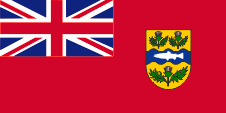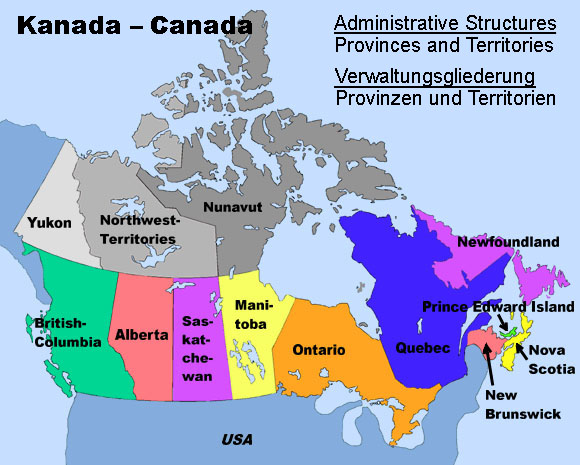mobile View, to the German Version tap the flag


- Canadian province
- own names:
– English: Nova Scotia
– French: Nouvelle-Écosse
• Flag
• Historical Flags
• Meaning/Origin of the Flag
• Coat of Arms
• Meaning/Origin of the Coat of Arms
• Map
• Numbers and Facts
• History
• Origin of the Country's Name
• regional Flags
– Acadia

Flag of the province of Nova Scotia,
ratio = 1:2,
Source:
Corel Draw 4, Flaggen Enzyklopädie







1625–1868,
Source, by:
Corel Draw 4, Flaggen Enzyklopädie






1868–1929,
Flag of the province,
ratio = 1:2,
Source, by:
World Statesmen,
Wikipedia (D)




The today's flag of Nova Scotia was officially hoisted for the first time on 19th of January in 1929. It is a scutcheon flag, because it shows the design of the coat of arms of the province. The provincial flag may, as in the other Canadian provinces, not only be used by governmental offices, authorities and departments, but also by private individuals. The current flag of Nova Scotia was probably in use as early as 1625 when King Charles I. gave Nova Scotia its current coat of arms. However, it is only proven in 1858. In 1868, it seemed that they had to submit to the British Ensign system. Normally the province would, like every other province too, not have had its own flag and should only have used the British flags or, from 1870, the Canadian flags. Nevertheless they wanted, like as in all other provinces, to have its own flag, which, like as in all other provinces, never was approved. They, apparently and significantly, introduced a Red Ensign, which showed the then coat of arms of the province in the flying end. A clear violation of the Ensign system, because a Red Ensign is always awarded by the British Admiralty in addition to the Blue Ensign. There was no Blue Ensign at all. Finally, in 1929, the old model was reintroduced. The historical flags of the province follow British specifications due to history. They are: Blue = Pantone 280, Red = Pantone 186, Yellow = Pantone 116. For today's flag they are: Blue = Pantone 293, Red = Pantone 186, Yellow = Pantone 122. United Kingdom introduced a flag system in 1864 in which:
• war ships fly the "White Ensign" (naval flag), a white flag often with an uninterrupted red St. George's-Cross and with the Union Jack in the upper staff quadrant of the flag,
• merchant ships fly a "Red Ensign" (also named "Civil Ensign" → civil flag, the real merchant flag), a red flag with the Union Jack in the upper staff quadrant of the flag, and
• governmental ships fly the "Blue Ensign" (flag for the use by the gouvernment → the actual state flag), a blue flag with the Union Jack in the upper staff quadrant of the flag.
Since 1865 ships of colonial governments were permitted to fly the Blue Ensign with a badge in the flying end of the flag. The respective governments were asked to design appropriate badges. Merchant ships and seafaring persons from colonies were only permitted to use the Red Ensign with a badge, then also named Civil Ensign, if permission has been given to the respective colony by the British admiralty. Such a badge was often a regional landscape representation placed on a disk, often showing ships, historical events or even a kind of a logo. Very often, a badge also showed the name of the country or a motto. Some British possessions, however, already had a coat of arms from the beginning, or their badge was replaced by a coat of arms over the years. To ensure a uniform appearance in the flying end of the flags, coats of arms and other symbols were displayed on a white disk in the size of the earlier badges. There were also exceptions, because some colonies did not use the white disk and placed their escutcheon or even coat of arms directly on the bunting, sometimes enlarged. Already in the '40s they started to remove the white disk and placed the coat of arms directly or enlarged. This conversion process was done gradually, nowhere at the same time and completely. In some British possessions, flags with the white disc are still in use, in others no more and in some areas are both variants in use, next to each other.
Source:
Volker Preuß,
Flaggen Enzyklopädie,
World Statesmen,
Die Welt der Flaggen,
Wikipedia (EN)


Escutcheon of Nova Scotia,
Source, by:
Corel Draw 4

There is a regular coat of arms for Nova Scotia, with a console, shield holders (supporters), withe a crest and the motto. Here is only depicted the central part of the coat of arms, the escutcheon. The escutcheon of Nova Scotia shows on white ground the coat of arms of Scotland medially above a blue St. Andrew's Cross. It is designed corresponding to the scottish flag, because the shield correlates with the scottish "Saltire" in a reversal of the colours.
Source:
Volker Preuß,
Wikipedia (EN)


Map:
Volker Preuß

Area: 21.345 square miles
Inhabitants: 1.001.907 (2011), thereof 80 % Anglo Canadians, 15 % Franco Canadians (Acadians), 2,5 % native Indians, 2 % of German and Dutch descent
Density of Population: 47 inh./sq.mi.
Capital: Halifax, 431.721 inh. (2017)
official Language: English
other Languages: French, German
Currency: Canadian currency
Time Zone: GMT – 4 h
Source:
Wikipedia (D),
World Statesmen

ca. 10.000 B.C. · first settlement by ancestors of Indians of the Micmac tribe
ca. 1000 A.D. · Normans reach the Canadian eastern coast
1497 · Giovanni Caboto (John Cabot), an Italian seafarer in the service of England discovers Labrador, Newfoundland and Cape Breton (Nova Scotia)
1603–1606 · Samuel de Champlain's expedition of colonization touches even the today's Nova Scotia
1608 · Champlain powers the merge of all French possessions in the today's Canada under the name "New France" and demands also the today's Nova Scotia
1621 · the English King James I., hwo likewise claims the peninsula, distributes land claims for noblemen from Scotia, for the securing of his demands, from there the name Nova Scotia
1663 · New France (including Nova Scotia) becomes a French crown colony
1713 · Peace of Utrecht, France has to cede Nova Scotia, New Brunswick, and the Island of Newfoundland to United Kingdom, the islands Royale (the today's Cape Breton Island), St. Jean (the today's Prince Edward Island) and St. Pierre/Miquelon however remain French
1730 · France builds the Fortification of Louisbourg on Royale Island
1751 · Nova Scotia becomes an own English colony
1749 · foundation of Halifax
1751 · by initiative of the English king George II. from the House of Hanover gets established the City of Lunenburg by German settlers
1756 · beginning of the Seven Years War
1758 · the English conquer the Fortification of Louisbourg
1763 · Peace of Paris, France has to cede all its north american possessions to England (British Northern America), except St. Pierre and Miquelon
1783 · immigration of thousands loyal US-Americans
1784 · division of Nova Scotia into four provinces ("sea provinces"), however under one common Governor General: Nova Scotia, New Brunswick, Cape Breton Island and Prince Edward Island, the provinces Cape Breton Island and Prince Edward Island get later re-annexed to Nova Scotia
1848 · United Kingdom grants Nova Scotia limited internal self government
1867 · establishment of the Confederation of Canada (Dominion of Canada – with an own parliament) because of demands for autonomy, confederation by the four founding provinces New Brunswick, Québec, Ontario and Nova Scotia
1873 · once more establishment and excorporation of the Province of Prince Edward Island
Source:
Atlas zur Geschichte,
World Statesmen,
Wikipedia (D),
Discovery '97

The name of the province dates back to the year 1621, when the English King James I. (James Charles Stuart) began to distribute land rights to nobles from Scotland.
Source:
Volker Preuß


![]()












